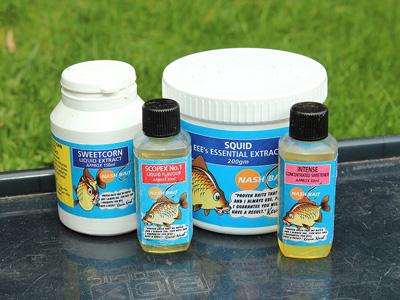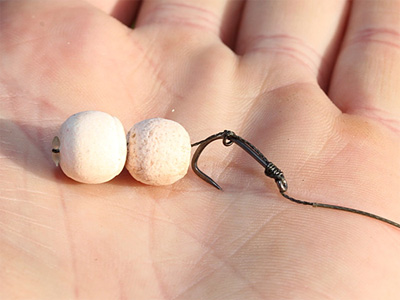Q. I can’t afford lots of maggots and casters but know how productive they are for tench; how can I get the most from a small amount of them?
I’ve found over the years that the most effective way to get the best out of maggots is to flavour them. There are a whole host of different things you can use from straight off the shelf in the local supermarket to dedicated additives and glugs from bait companies.
 If it’s the supermarket route then you won’t go far wrong with turmeric or curry powder and both are fantastic additives that really give your bait an extra dimension. If you’re working with, say, two pints of maggots then one tablespoon of powder added the night before fishing can be devastating and give them a real kick.
If it’s the supermarket route then you won’t go far wrong with turmeric or curry powder and both are fantastic additives that really give your bait an extra dimension. If you’re working with, say, two pints of maggots then one tablespoon of powder added the night before fishing can be devastating and give them a real kick.
If it’s a liquid flavour that is to be used then a little more time and preparation is needed.
Firstly you need to riddle your maggots to remove any sawdust or maize meal they are stored in. This is essential as when you add any flavour it will coat the maggots and not get absorbed by anything else. Once you have added your flavour make sure the maggots are well mixed and the liquid has been evenly spread out and re apply some maize meal or sawdust to stop them sweating.
Don’t worry about re adding sawdust as if it’s evenly spread you’ll be fine and the maggots will take the flavour in through their skin even if it gets mixed with the sawdust a little. With liquids you need to be careful you don’t overdo it and I find 5ml of flavour per pint is more than enough as long as it’s not a concentrated flavour. If it is concentrated then 1ml per pint may well be enough to do the job.
The flavour I prefer to use is the Scopex Squid Frenzy InJuicer from the Nashbaits Fish Frenzy Range. This product isn’t concentrated so it is literally impossible to over flavour the bait and the aforementioned levels per pint of maggots is perfect to give them a boost.
When it comes to applying the bait to your chosen swim and making it go a little further a block end feeder is perfect. If you cover the main body of the feeder with dark coloured masking tape you will only leave a few holes for the maggots to escape from. This will give you a constant trickle of bait into the swim for a prolonged period of time and with the extra flavour you’ve added it will put a scent into the water column keeping the fish active for much longer.
With your casters the best way to get the most out of them is to use a cheap particle bait to bulk them out. If you’re targeting tench then look no further than hemp. A 20kg sack of hemp can be bought for a very good price and most pet stores sell it by the kilo so if you don’t have storage space then just buy what you need a session at a time.
Using a ratio of three parts hemp to one part caster will see just one or two pints of casters last a long time and help your bait go that bit further.
Best of luck! Lewis Baldwin
Q. I fish a very silty carp water, what is the best type of rig to use to make sure I present my baits properly?
Carp love to feed in silt, filtering out all of the tasty morsels within it and often digging right down to get at the good stuff so don’t be put off by it.
The first thing to address when fishing for carp in silty lakes is your lead arrangement; bolt rigs and in-line leads should be avoided as they drag the rig right into the silt, which could potentially blunt or mask the hook point rendering the whole rig useless. My preferred set-up for silt is the helicopter rig, on which the hooklink is able to slide along the leader or mainline and is stopped by a lightly fixed bead which can be adjusted to allow for different depths of silt, meaning that the lead can sink right to the bottom of the silt and yet your hooklink and bait will still sit nicely on top.
I use a 1oz lead if the distance I’m fishing allows and as well as the lighter than average weight I like to choose a shape of lead that won’t sink right in – such as a flattened square or round one. My hooklink is generally about 12 inches long, but I will change the length throughout a session until I find the best length for the situation. The bead on the rig that stops the hooklink is generally set at around ten to twelve inches, which I imagine in most cases is just enough to slightly pull the hooklink into the silt and aid camouflage, but still leave the hook bait in the top layers.
 To combat the risk of the hook point getting damaged or masked I add one or two dissolving Chain Reactions that will protect the hook initially but eventually dissolve to leave lots of attraction for the carp to home in on. A small P.V.A. bag will do the same, but is not as easy to use.
To combat the risk of the hook point getting damaged or masked I add one or two dissolving Chain Reactions that will protect the hook initially but eventually dissolve to leave lots of attraction for the carp to home in on. A small P.V.A. bag will do the same, but is not as easy to use.
I don’t mind using big hooks or heavy hooklinks in silt as carp that feed in the black stuff will be used to picking up all sorts of debris, such as twigs and stones, to filter out the food within them, so a size six hook shouldn’t put them off too much.
A common mistake people make when presenting a bait to carp feeding in silt is to use a pop-up bait. When a carp is feeding in silt, it’s feeding IN the silt, not 3-inches above it so in terms of bait I like to use small heavy baits of around 10-12mm that will sit just below the surface layer of silt right where the carp look for food. In my own experience I’ve found that white baits, in particular Nash Baits Amber Strawberry Attract, work particularly well on silty lakes.
Bernard Anderson
Any Questions?
With carp and specialist anglers of the calibre of Paul Garner, Tony Gibson, Alan Storey, Steve Pope, Ted Bryan, Alan Blair, Mark Barrett, Lewis Baldwin and Bernard Anderson – to name but a few – the Nash Peg One team has a wealth of experience covering just about every species that swims and the expertise of the whole team is on tap for everyone at FishingMagic to take advantage of in these Q and A sessions.
If you have any questions that you would like the team at Nash Peg One to answer in the next instalment then please e-mail them through to editor@fishingmagic.com










